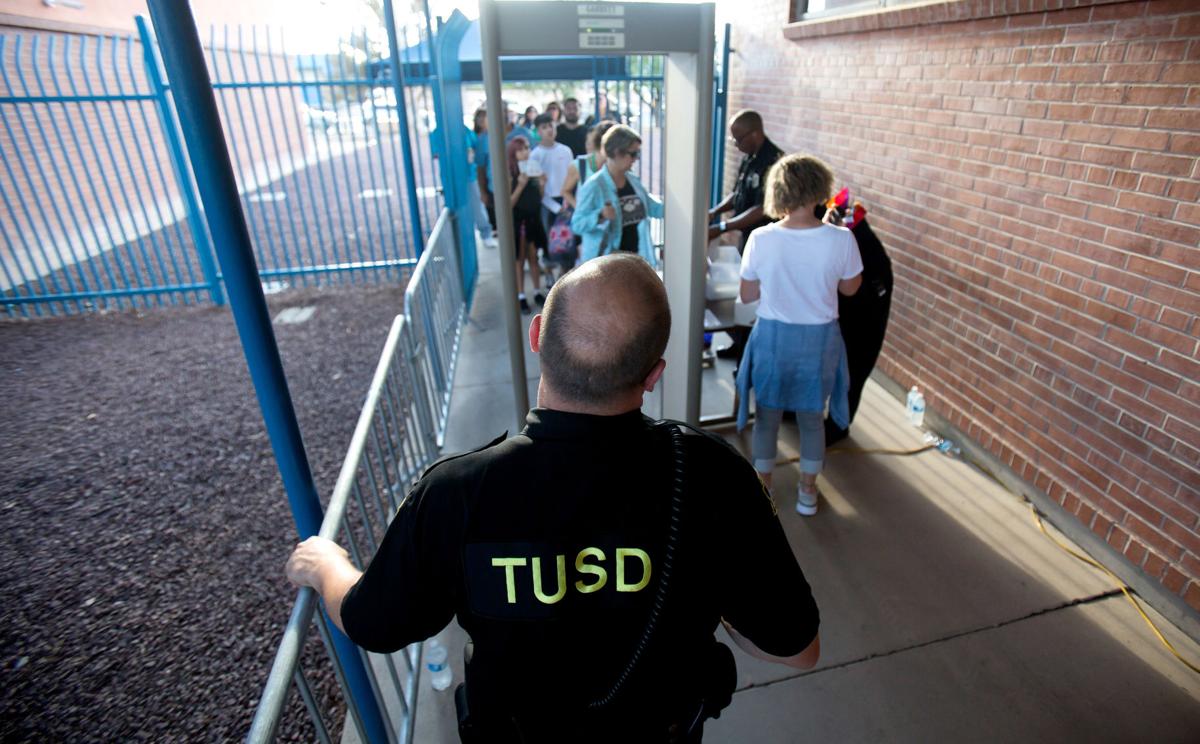School safety officers in ĂŰčÖÖ±˛Ą Unified schools will likely be carrying Tasers and body cameras soon, after a unanimous vote by the district’s Governing Board on Tuesday.
“It gives armed officers an alternative to the use of a firearm, and that can reduce liability no matter how you slice it,” school safety director Jeff Coleman told the board at Tuesday’s meeting. “We rely on our security tools to protect life and safety. This tool can reduce injuries to officers and also the people that we are encountering by as much as 60 percent.”
The Tasers are only meant for use on adult intruders who are a direct threat. The policy proposal prohibits using Tasers on anyone under 18, unless deadly force by an officer was already justified.
Although the board voted to purchase equipment for its 24 safety officers, they will still need to go through a policy development process before the Tasers are issued.
People are also reading…
TUSD’s safety officers are not assigned to specific schools but instead travel to any campus where they are needed. The safety officers respond to an average of 2,500 alarms a year, which are primarily at night and on weekends, Coleman said.
Fourteen of the safety officers work the day shift and respond to a variety of calls, including suspicious people outside schools and soft lockdowns. Coleman says campus lockdowns happen frequently because of suspicious or dangerous activity near a school.
Twenty of the school safety officers are armed with guns, but none of them currently carry Tasers. Coleman says Tasers provide an important “intermediate weapon.”
Safety officers are authorized to use deadly force if the officer or someone else’s life is in immediate danger, Coleman says.
Giving them Tasers is meant to provide a less-lethal option for subduing potentially dangerous people, he said.
Coleman gave the board two real-life examples of when a Taser would have been useful. Both involved an adult intruder who was brandishing a weapon and advancing on a safety officer. In each example, the officer had a gun pulled, and the intruders eventually dropped their weapons.
Most of TUSD’s safety officers are retired law enforcement, corrections officers or military veterans. Before becoming school safety officers, they go through a field training program for several months, which includes 40 hours of firearm training, defensive tactics, state law and district policies regarding the use of force, Coleman says. The officers also go through a 24-hour Department of Homeland Security class on how to respond to an active shooter.
TUSD also has 12 school resource officers, as opposed to the safety officers who work for the district.
Resource officers already carry Tasers along with their guns and are trained law enforcement officers who work for either ĂŰčÖÖ±˛Ą police or the Pima County Sheriff’s Department and have been assigned to certain schools for the last five years, according to Coleman.
These officers are assigned to two K-8 schools, three middle schools and the rest are at high schools, he said.
The cost of 25 Tasers, 25 body-worn cameras and the initial training is just under $195,100, which can be paid over five years.
Officers will use the body-worn cameras only when on a service call or if they encounter a potentially volatile situation. Unless they are being held as evidence, videos will only be maintained for six months. TUSD buses already have cameras, and some schools do too, Coleman said.
Before the officers carry Tasers, two school safety personnel will attend a 16-hour accredited training course.
They will in turn train the other school safety officers about proper usage of a Taser for six to eight hours. After the initial training, all safety officers will receive six to eight hours training annually, Coleman said.
“It’s like every other tool that we carry. … We train. We have strict policies, and we enforce those policies,” he said about officers carrying Tasers. “We hold people accountable and give them the tools to do their job.”










